Student apathy is a growing concern in higher education institutions, affecting academic performance, retention rates, and overall student satisfaction. As students face pressures from academic demands, financial burdens, and social challenges, administrators and faculty play a crucial role in addressing this issue.
As a decision-maker for your college, you have the power to learn about your students and engage them in ways that best suit their needs. Being aware of apathy, its causes, and its effects is just the first step. Implementing personalized learning approaches or taking advantage of engagement technologies are other ways you can motivate, empower, and reengage your learners.
In the age of apathy, students feel powerless, disengaged, and lack urgency. You might notice more and more students skipping class, turning in assignments late or incomplete, or using phones during lessons. But why are they disengaged? There are many potential reasons:
Students in higher education have faced several challenges in recent years, including a pandemic, economic uncertainty, and climate change. Higher rates of loneliness, social disconnection, and trouble coping with the COVID-19 pandemic could be contributing to apathy in general. A top study found that three-fourths of college students experienced household disruptions, and over 90 percent reported that they or their families or friends had trouble coping with stressors relating to the pandemic.
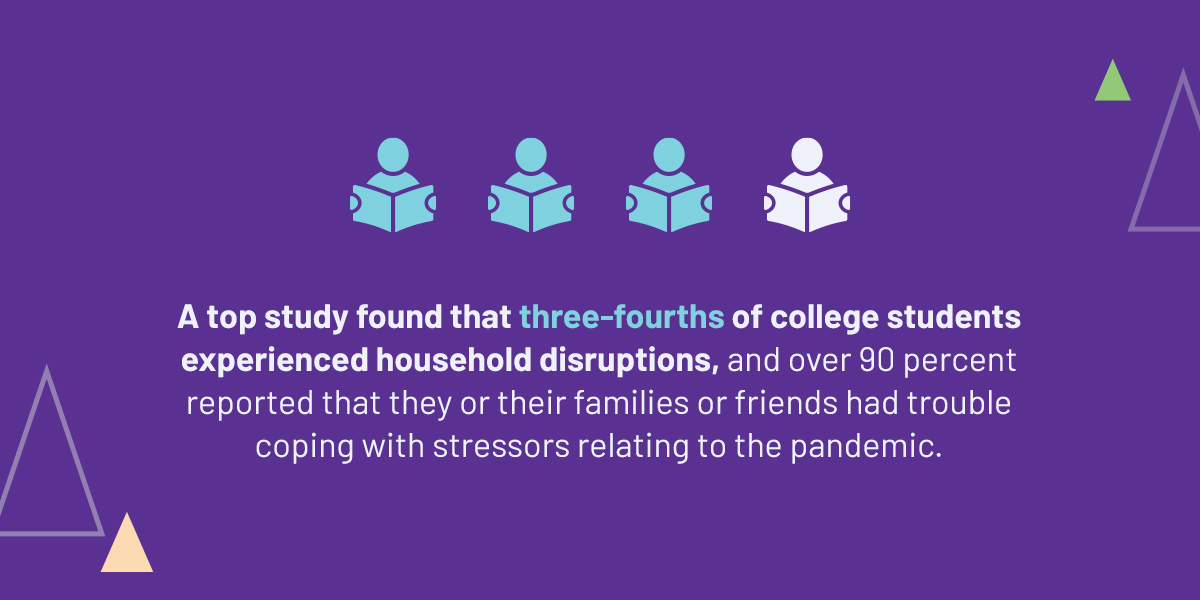
These findings suggest that pessimism, trauma, and hopelessness have made it difficult for students to imagine a future in which achieving a college degree, attending classes, or completing coursework could make a positive difference.
A lack of relevance in the curriculum may make it challenging for students to see the value in learning and schoolwork. They may feel a loss of agency or ownership over their education, longing for a learning style that works for them and a curriculum that aligns with their interests and future goals.
For example, the newer generation of students are exposed to multimedia elements like images, videos, and audio and engage in interactive games and apps. As a result, they expect faculty to use technology to make the learning process more effective and engaging.
When we feel overwhelmed or exhausted, our ability to focus and engage declines — often leading to physical and emotional fatigue. It works the same way for college students juggling multiple responsibilities, including rigorous academic workloads, part-time jobs, and extracurricular activities. The overwhelming pressure can lead to burnout, causing students to detach from studies and campus life. They may also disengage from their academic pursuits and lose interest in the activities they once enjoyed.
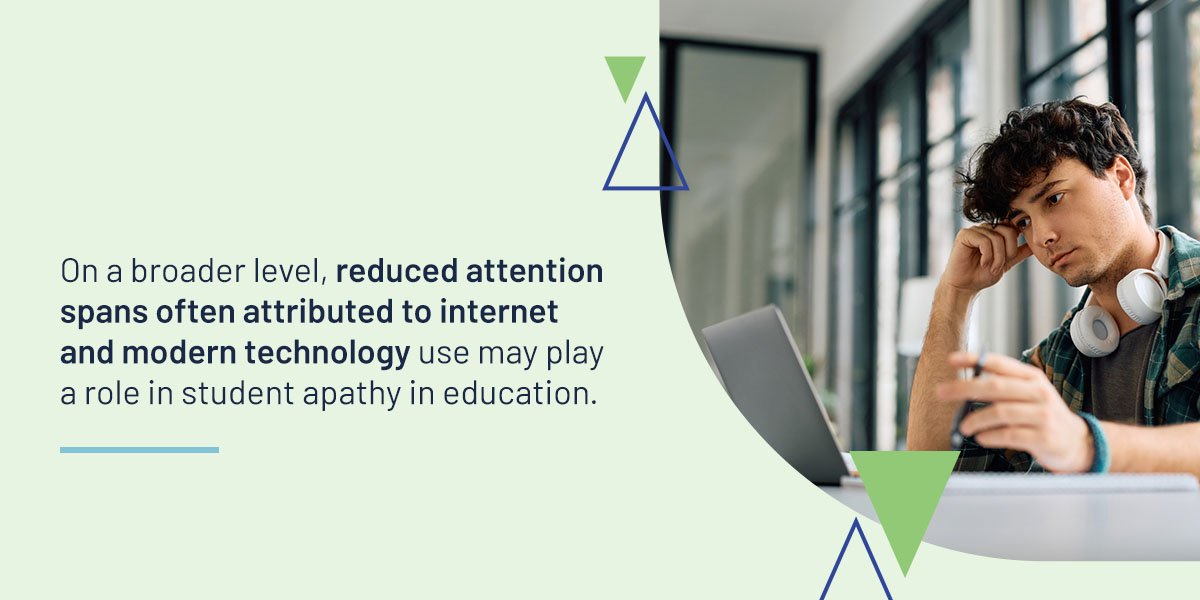
On a broader level, reduced attention spans often attributed to internet and modern technology use may play a role in student apathy in education. Social media and smartphones promise instant satisfaction and easily digestible content, which can make it challenging to focus on mentally challenging tasks. Considering the numbness and overstimulation most students face, it makes sense that they’d prefer easy, quick sources of relief over more tedious academic work.
We are already seeing the effects of student apathy in our education system — in 2021, colleges saw the lowest undergraduate enrollment rates in years, with even fewer in 2023. Apathy can affect college students in various ways, impacting academic performance, social interactions and overall well-being:
Addressing student apathy in college requires more than a one-size-fits-all approach. Faculty members should take multifaceted action, considering each student’s unique needs and interests. Read on to learn about apathy and how to motivate and reengage your learners.
Be patient and understanding toward students struggling with apathy or lack of motivation. Building relationships is a powerful strategy for combating apathy because it creates a sense of belonging and connection in the classroom. When students feel that their professors genuinely care about them, they are more likely to engage in the learning process. They’ll feel valued and respected, in turn fostering a positive environment where they are excited to attend classes, participate, and complete coursework.
In the face of unprecedented challenges, educators should prioritize the well-being of their students — including addressing physical and mental health as well as academic needs:
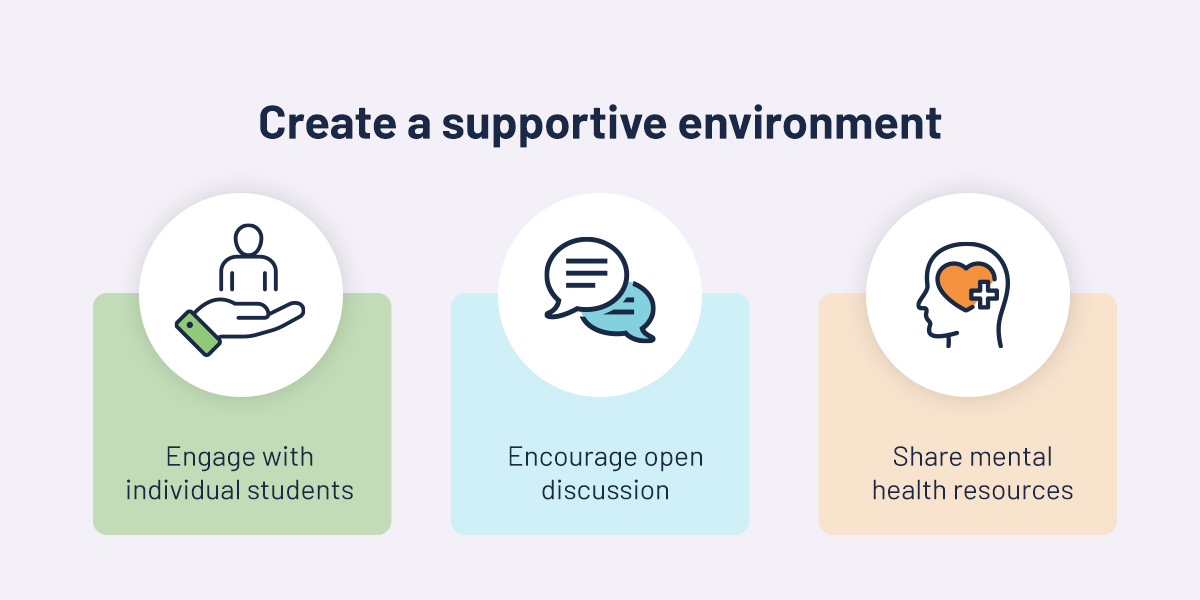
Creating a nurturing environment and championing each student’s strength and resilience can lead to their academic success and mental and social wellness. It also lets you build genuine connections, creating an environment of trust, respect, and empathy to combat apathy.
As newer generations are more exposed to multimedia, they may be more likely to engage when these elements are incorporated into learning. Game-like elements like points or leaderboards in your classroom can encourage healthy competition and participation, while multimedia tools can make lessons more accessible.
For example, platforms like Kahoot!, Padlet, or discussion forums facilitate real-time interaction during your lectures, allowing you to create fun quizzes and competitions that motivate apathetic students to engage with the material.
Multimedia tools, such as podcasts or videos, can accommodate diverse learning styles and make lessons more relatable. Tools like Nearpod or Edpuzzle let instructors create hands-on presentations where students can participate in real-time polls or answer questions embedded in videos. By leveraging these technologies in the classroom, professors can create an engaging learning environment, encourage collaboration, and reduce apathy.
Students take classes for several reasons, many of which include simply meeting a requirement, filling a gap in their schedule, or balancing demanding courses with easier ones. To engage students, explain why your class is meaningful and valuable and why attendance and participation are crucial. Convey your passion for the subject matter — enthusiasm is contagious, and showing your excitement while teaching the content can inspire students to engage more deeply.
On the first day of courses, ask students for their input to help you gauge their interests. You might even use technology solutions to collect student feedback and inform curricular changes. Integrating those topics into the curriculum can make learning more relevant and keep students engaged and actively participating. Incorporate topics that resonate with each student’s passion or future career aspirations, such as discussing case studies that align with their goals, to spark interest and motivation.
Creating a classroom environment where students feel heard, valued, and respected is essential. Building relationships based on trust and empathy establishes a safe space for students to express themselves and take ownership of their own education.
Combating student disengagement requires understanding the learning styles your students benefit from most. While nonstop lectures, Socratic questioning, and similar approaches can cause students to disconnect, interactive learning may enhance the learning experience and encourage students to participate. Use personalized approaches to reach your students:
By incorporating these personalized and interactive approaches, professors can create a more engaging classroom environment that reduces apathy and fosters a love for learning.
Make learning relevant and meaningful to in each student’s life, incorporating real-world examples and projects that provide a sense of purpose and promote creativity. Relate your course to current events or show how the knowledge students gain can be used in everyday life. Showing the relevance of their studies can make them more meaningful to your students. It also fosters a sense of ownership over their education, a top concern for apathetic students.
Emphasize how your course content applies to various careers. Showcase the skills and knowledge your students acquire as enhancing their career prospects. Invite guest speakers from relevant industries or share the success stories of alumni who benefited from your course, making it clear that the material has practical applications.
Clearly outline what students will gain from your course, including skills, knowledge, and potential certifications. When students understand the specific outcomes of their learning, they recognize the value of their investment in education.
Constructive feedback and positive reinforcement are powerful tools that can help reduce apathy among college students. When you integrate them, you can foster a growth mindset and encourage active engagement. Key benefits include:
Notice statements and regular checkpoint sheets can help track progress and provide timely feedback, guiding students in the right direction throughout the school year. Additionally, provide prompt feedback so students understand their performance while the material is still fresh in their minds.
Incorporate collaborative learning models in your class, such as study groups and peer mentoring opportunities, to reduce student apathy in college. Collaboration lets students support each other academically and socially, fostering a space where they can share their thoughts and feelings and reengage with their education. Group activities and social events can reduce isolation and loneliness, which often lead to apathy.
For example, assign group projects that require students to work together to solve problems or create presentations. This allows them to share ideas, build on each other’s strengths, and have more autonomy over their learning process. Peer teaching opportunities can also be effective ways to increase engagement, as students take turns teaching certain topics or concepts to classmates, reinforcing their understanding while building confidence and communication skills.
Additionally, small group discussions on course material or relevant topics allow students to express their thoughts and challenge each other’s ideas. These group talks can promote critical thinking and deeper engagement with the content. Leverage online collaboration tools like Google Docs or Slack, where students can also work together outside of class.
Deepen emotional engagement by providing students with reflection opportunities. Journals, discussion prompts, or reflective essays encourage apathetic students to think more about what they’ve learned and how it applies to their lives. These practices also allow them to engage critically with their learning process and recognize their progress. Students become more aware of their challenges and motivations, which can reignite their interest in the subject matter. Reflective strategies include:

These reflective practices allow students to identify their strengths and areas for improvement, which can provide a sense of ownership over the learning process. Reflection also helps them analyze their thought processes and connect concepts more meaningfully.

Participating in clubs or volunteering are other helpful ways to reduce student apathy, as they allow students to connect more with their school environment. As a college instructor, you can actively promote campus organizations and activities related to your course material. Integrate discussions about clubs or volunteer opportunities into your lecture, underscoring how these experiences strengthen learning and personal growth.
Additionally, you can create assignments that involve activities outside of the classroom, such as field research projects, industry visits, or community service. Promoting these extracurricular activities can motivate students to engage more deeply with their learning and with peers, ultimately helping reduce apathy and enhancing overall satisfaction.
For higher education leaders and administrators, addressing student apathy requires a multifaceted approach. By implementing initiatives collaboratively across departments, you can create an engaging campus environment that promotes student success while reducing feelings of empathy.
Create a clear vision for student engagement across all departments and align initiatives accordingly. Student engagement and well-being should be at the center of your vision, reflecting the diverse needs and interests of your students. Plan with students, faculty, and staff in mind to ensure your vision resonates with stakeholders and addresses apathy’s root causes:
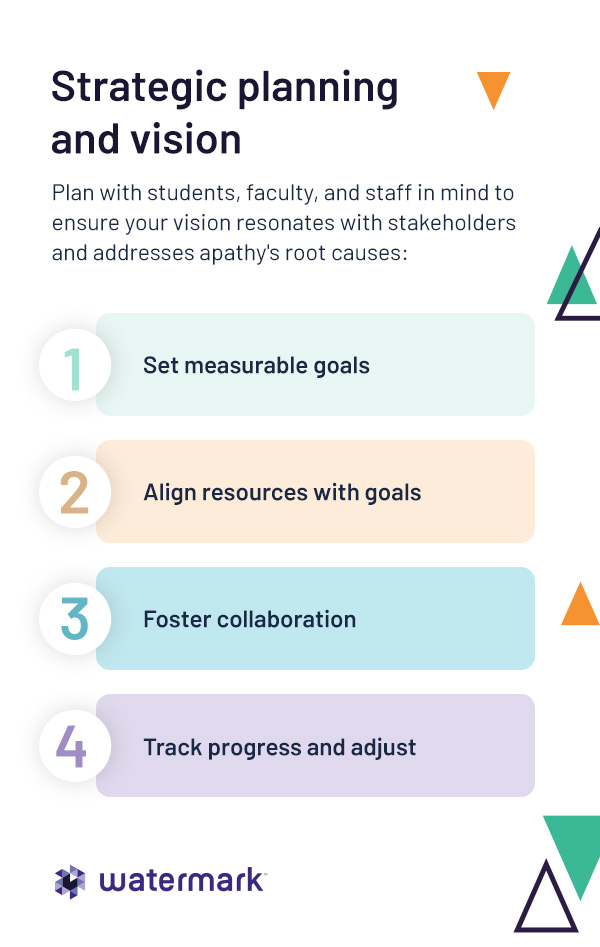
By developing a comprehensive vision, setting measurable goals, fostering collaboration, and tracking progress, you can enact meaningful change on your campus. The proactive approach can reduce apathy while cultivating a thriving academic community where students feel valued and excited to participate in their educational journey.
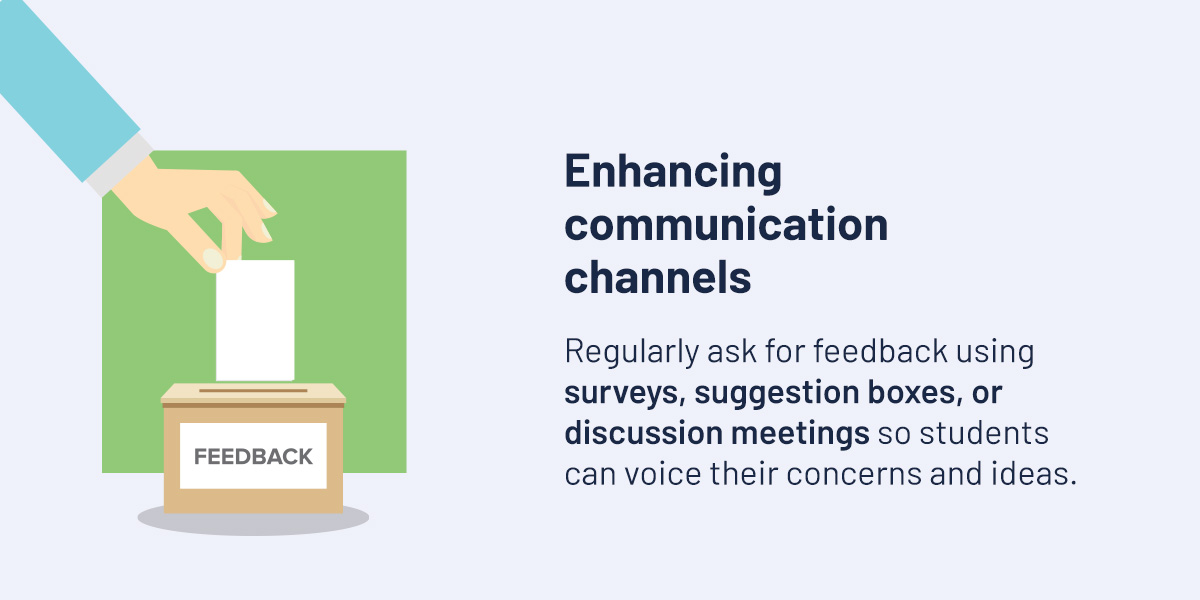
Establish clear and open lines of communication between students and administration. Regularly ask for feedback using surveys, suggestion boxes, or discussion meetings so students can voice their concerns and ideas. Students may feel more empowered to speak up about apathy and strategies that might help with focus and engagement. You also demonstrate that your student body’s opinions are valued, fostering a sense of community and belonging on your campus.
For example, taking student input into account, you might revamp orientation for new students and incorporate team-building exercises, mentorship pairings, or other initiatives that help students navigate college life. A strong start for new students can promote ongoing engagement and stop apathy in its tracks.
SEL programs are structured initiatives that aim to improve each student’s social and emotional skills. They are invaluable in the age of apathy when students face tough times and unprecedented challenges. These courses and their principles can help students navigate college life with ease, so they can focus on learning. You might integrate SEL components into your orientation programs for first-year students and beyond.
For example, you might offer workshops that teach students how to manage stress, build resilience, and develop healthy relationships. Equipping students with these skills early can help them feel more connected to their peers and the campus community. Implementing ongoing SEL initiatives throughout the academic year can also be beneficial, such as hosting workshops or seminars focused on mental health awareness or conflict resolution.
These programs benefit students by:
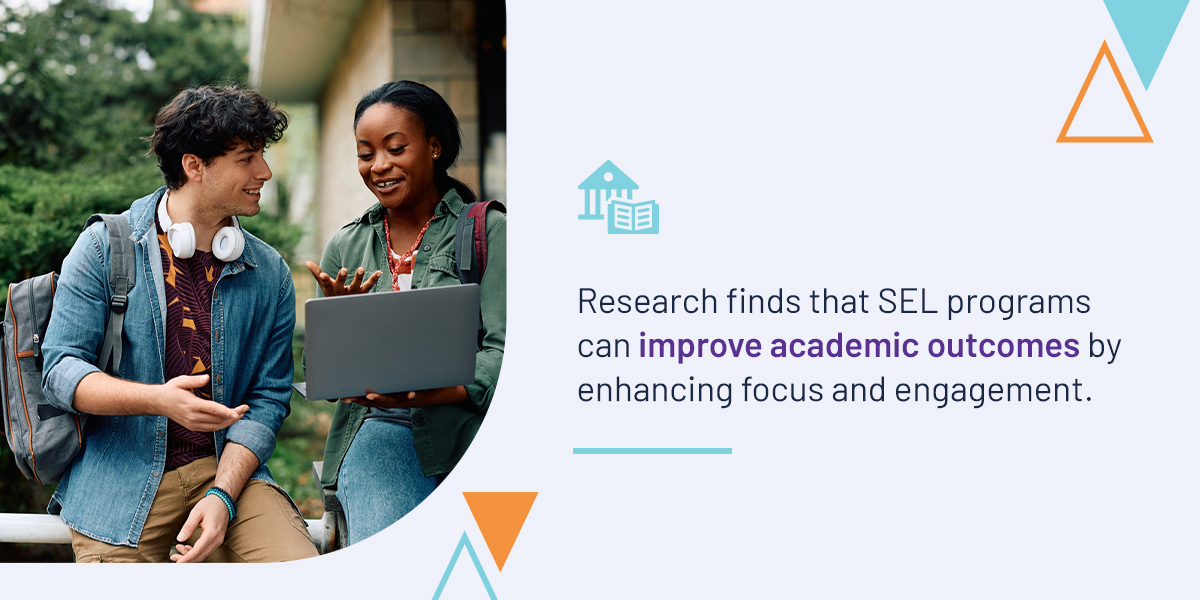
Research finds that SEL programs can improve academic outcomes by enhancing focus and engagement. They can also build resilience by providing apathetic students with coping strategies. As an educational leader, you have the power to implement SEL programs and incorporate their principles into existing academic curricula. Training teachers and staff on SEL concepts and strategies can create a supportive environment for students.
As a higher education leader, you play a crucial role in securing approvals and allocating budgets to reduce student apathy. Adopt a strategic approach that aligns your budget decisions with engagement initiatives and student well-being.

For example, allocating funds to expand extracurricular activities like clubs and recreational sports allows students to connect with peers outside the classroom. Studies show that involvement in these activities is linked to higher levels of student satisfaction and retention. Invest in support services, allocating your budget toward academic advising, counseling services, tutoring, and other support programs.
Embracing innovation and bringing exciting experiences to classrooms can reduce apathy and reengage learners. Allocate funds toward technologies that enhance the student experience, such as immersive technology that allows for hands-on opportunities so students can demonstrate the skills they’ve learned. New lab equipment, campus computers, or virtual reality learning opportunities can make learning more exciting and relevant.
To gain approval for budget allocations, present compelling data that highlights the extent of student apathy and its impact on retention rates, academic performance, and overall campus culture. Focus groups, surveys, and engagement analytics can provide evidence of the need for changes on your campus. For instance, if your data reveals low participation in extracurricular activities or clubs, you might target funding for those programs.

Keeping stakeholders involved in the process is crucial, as you can gain input from various perspectives, prioritize your budget, and demonstrate commitment to addressing student concerns. Pilot programs can also help you secure funding for larger initiatives, such as starting a small-scale mentorship program to show its effectiveness in engaging students.
Once funding is secured, you’ll need to continually assess the effectiveness of your allocated resources. Report your outcomes to stakeholders on a regular basis to maintain transparency and accountability and justify future budget requests. Aligning your budget requests with institutional goals and leveraging data-driven insights can help you reduce apathy on campus.
Professional development plays a crucial role in equipping educators with the tools and strategies necessary to navigate apathy. Investing in ongoing professional growth and learning allows your teachers to stay ahead of best practices and use innovative approaches for engagement. As a higher education leader, you’ll need to allocate extra time for collaborative planning, sharing effective practices, and refining instructional techniques:
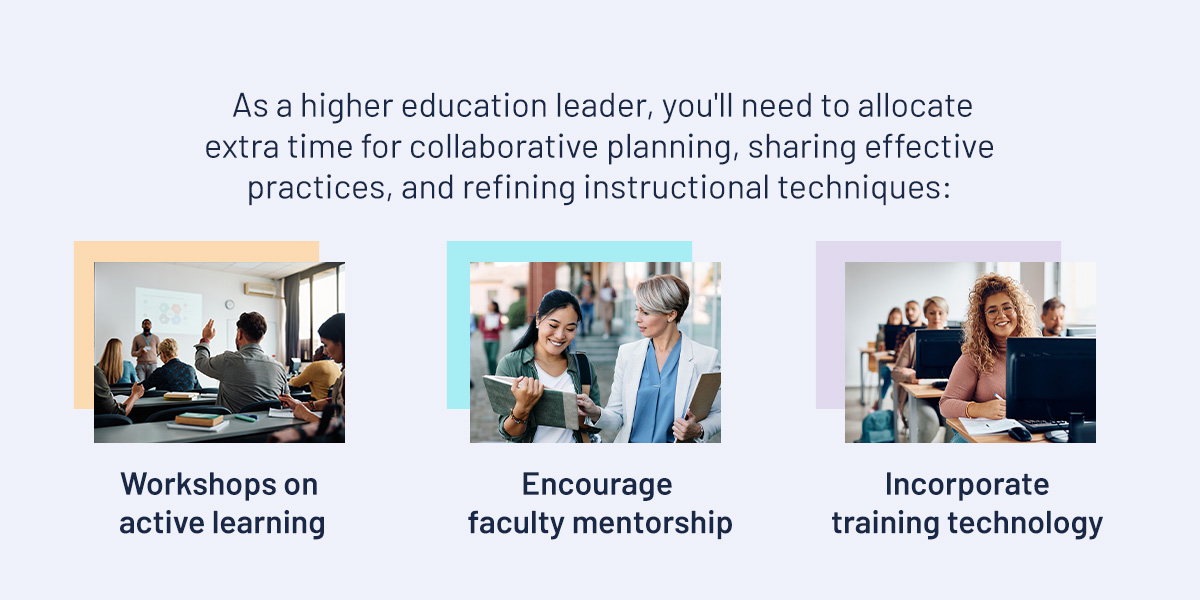
Creating a community of practice among faculty is crucial for enhancing your professional development efforts. Encourage regular meetings to share successes, challenges, and strategies. In no time, your institution will become a supportive network that promotes collaboration and shared learning.
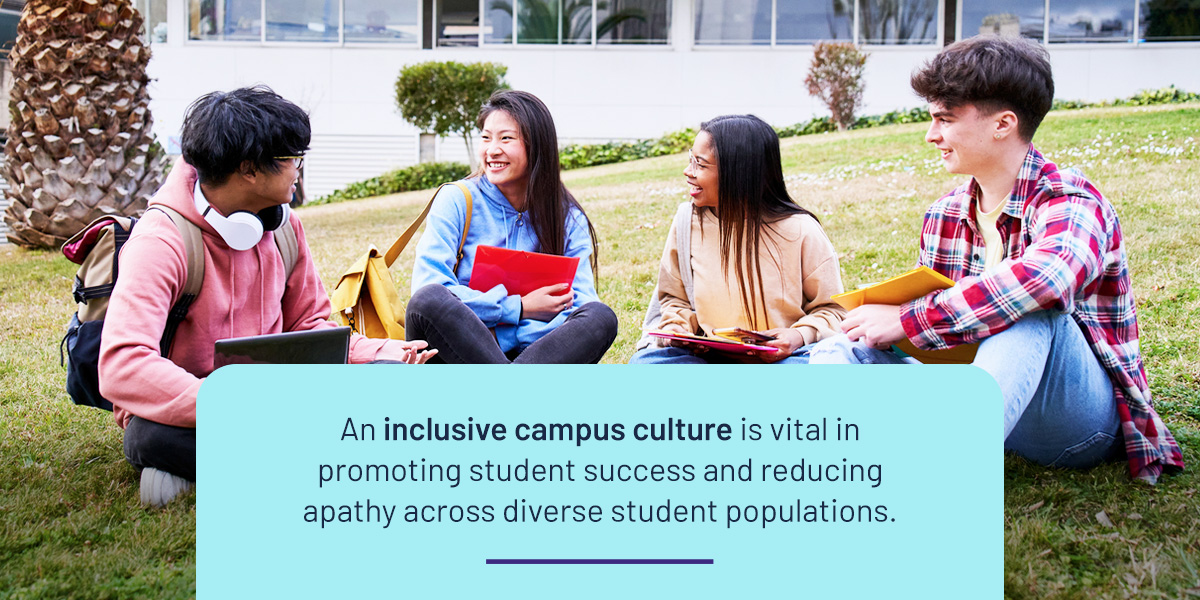
An inclusive campus culture is vital in promoting student success and reducing apathy across diverse student populations. Higher education leaders should prioritize and allocate funds toward diversity, equity, and inclusion (DEI) training initiatives. This way, educators can create more inclusive classrooms that respect and value all student backgrounds. Like SEL training, DEI can equip faculty with strategies to ensure all students are connected to their campus, fostering a sense of belonging that is crucial for combating apathy.
As part of an inclusive culture, you’ll need to establish clear policies that promote equity and ensure all voices are heard and respected within your institution. Cultural competency training involves staff and instructors learning more about unique challenges faced by underrepresented groups. These programs can foster empathy and understanding — crucial in addressing apathy and its root causes. Other DEI initiatives include:
Promoting cultural events or speaker series can enrich the campus experience, improve engagement, and encourage dialogue among students of various backgrounds. Schedule forums and discussion groups regularly where students can voice their concerns and suggestions to improve upon diversity issues. Prioritizing these initiatives means cultivating an inclusive environment, reducing apathy, and increasing engagement among all students.
Take advantage of advanced technologies that promote interaction and offer innovative solutions to combat apathy. Leveraging these tools can help your college or higher education institution create a more engaging environment of active participation. Examples include:

By integrating these technologies into your educational framework, you can enhance student engagement and create a vibrant campus culture that actively combats apathy.
Apathy is a complex topic that requires a comprehensive approach from college faculty and administrators. While navigating the complexities of modern education, remember the ultimate goal — to nurture the next generation of learners and leaders. By embracing engagement strategies, setting high standards for academic excellence, and fostering a culture of continuous improvement, you shape a brighter future for students.
Watermark can help you achieve your institution’s initiatives by providing the software and technology solutions you need to identify initiatives and increase student engagement. Our mission is to help you serve your students through data-driven decision-making. Our fully integrated software solution offers streamlined data collection and analytics capabilities for student success, curriculum mapping, and more.
Contact us to learn more or request a live demonstration to see how our solution can help you glean value from your data and strengthen student engagement.
